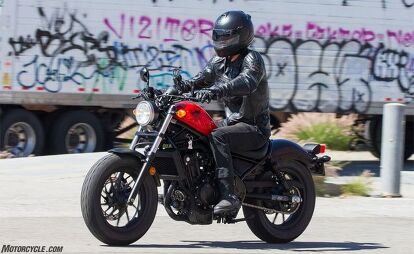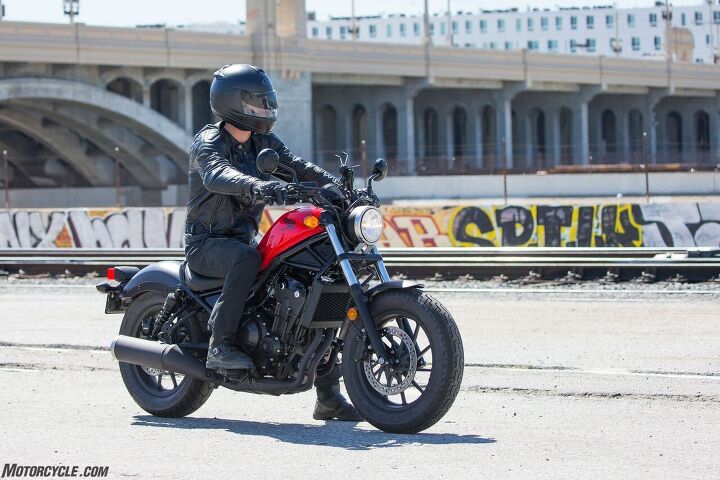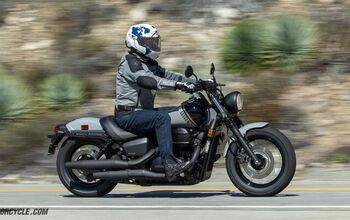2017 Honda Rebel 500 Review: First Ride
Hondas entry-level cruiser is reborn to woo the hearts and minds of Generation Y
I’m not sure if it’s my naturally rebellious nature, being a man who microwaves his food still in the tupperware and even known to occasionally fill water cups up with soda (that’s right, bitch), that got me the chance to head up to Venice Beach, California, for the launch of the new Honda Rebel 500, but I think it might be because the rest of the Motorcycle.com staff (except Troy) is in the tin-foil reusing, cabbage-scented stage of life.
2017 Honda Rebel 500
| Engine | 17.5/20 |
| Suspension/Handling | 10.5/15 |
| Transmission/Clutch | 9.0/10 |
| Brakes | 8.0/10 |
| Instruments/Controls | 4.0/5 |
| Ergonomics/Comfort | 9.0/10 |
| Appearance/Quality | 8.5/10 |
| Desirability | 7.5/10 |
| Value | 8.5/10 |
| Overall Score | 82.5/100 |
The Rebel was first introduced in 1985 as a way for Honda to target a younger generation, typically new to motorcycles, and broke. Which is especially true today where a coffee and bagel costs an hour of labor, and the idea of owning a home almost anywhere in California is a long-off and mystical dreamscape. With strange quinoa and farro dietary options on every corner, Los Angeles is the ground-zero dwelling of the hip Instagram demographic that Honda hopes to see straddling its extremely user friendly, affordable, and bare-bones styled new Rebel, which starts at a very reasonable $5,999 for the base model, and $6,299 for ABS.
I think the bike looks awesome. I am a huge fan of the minimalist, exposed, and simple styling of the Rebel. The classic large round LED headlight at the front, black trellis frame, and angled teardrop tank all are simple and work well together. You can get the 500 in Tennis Ball Yellow, Matte Silver, Red, and Black; the ABS model is strangely available only in Black. And even though the Rebel comes in a smaller displacement (more on the Rebel 300 next week), it has the styling of bigger cruisers. The Rebel’s lead engineer, Keita Mikura pointed out it shares its fat front 130/90-16 tire and 150/80-16 rear with bikes like the Indian Scout.
The stripped-down styling leaves a lot of room for customization, something that Honda really wants to encourage with the Rebel. The steel rear fender is purposefully designed to be completely removable via a couple bolts, giving the bike a full-on bobber look. I personally would rip that rear fender off and throw some clip-ons on ol’ bessy like the custom P-40-styled Rebel 500 seen below, but that’s just me.
The Rebel has gotten a huge performance upgrade in addition to its makeover. Instead of that weezy old air-cooled carbureted 250cc Twin (or the old 450 Twin), the Rebel 500 gets its ponies straight from the CBR500R/CB500F/CB500X 471cc fuel-injected liquid-cooled parallel-Twin with four valves-per-cylinder, which has been tuned for the Rebel to deliver better bottom-end power than its sportier cousins. There is plenty of fun to be had on the Rebel 500; while it’s not going to win many drag races, it is a perfectly capable, tried and true powerplant that you can still rip around on with ease and cheapness, since it’ll go 60 miles on a gallon of gas – a thing you will appreciate considering its rather small 2.96 gallon fuel tank.
The transmission is plenty smooth with no need to fight through gears, and the clutch is nice and light. At highway speeds, however, you’ll find a buzz throughout the bike at around 65 mph. It’s not going to rattle your fingers numb or coax a bowel movement out of you, but it is noticeable and mellows out above or below that range in sixth gear. But the comfort and handling of the Rebel is what allows its motor to shine.
The riding position is natural and perfect for this style bike. I am very happy Honda didn’t go with the the outstretched cruiser pegs that tend to make me feel like I am hanging on for life by the bars at high speeds. The pegs are in a natural position, and the seat is a bit firm but comfortable. The bars have been positioned in a solid location that has the arms out straight with a slight elbow bend. Altogether the Rebel has an approachable and comfortable stature with a nice and low 27.2-inch seat height.
The Rebel is also nimble, and with its raised footpegs, cornering isn’t something that will make you pucker your keester, well, depending on the situation. Navigating at slows speeds is easy and natural, and at higher speeds you’ll find it… semi-confident and sturdy. It really hits the sweet spot of maneuverability in situations such as parking lots and heavy L.A. traffic. But cornering confidence is dented once you realize how squishy the suspension is. One of the first things I noticed is how much the 41mm fork compressed with a simple push on the front end with the bike stationary and the front brake locked. The softness is nice in certain instances, providing a cushy ride, but it takes on a floaty-ness underneath you if you hit a series of bumps while hauling ass. This softness works against the performance promises offered by decent cornering clearance from the relatively high footpegs. If you’re ripping around on the Rebel, you’ll find that 4.8 inches of front travel disappears quickly; its rear 3.8 inches of travel on its dual shocks was better controlled.
The Honda Rebel also received an upgrade in the brakes department from the previous Rebel’s rear drum and lonely front disc. You’ll now find disc brakes at the front and rear, which provide plenty of stopping power for the 408-pound cruiser. You can brake hard with confidence on the fat front tire and not worry about pinching your fingers off with the brake lever like I did on the 2015 Harley-Davidson Street 750 that I had tested when it was first released. Everything on this bike feels a bit “affordable” but it is Honda affordable, which means “pretty good.”
Considering the intended riding style for this bike and its reasonable price, great styling, quality parts and materials, the Rebel 500 is solid choice for beginning or intermediate riders when it hits the showroom floor in April.
2017 Honda Rebel 500 Specifications | |
|---|---|
| Engine Type | 471cc liquid-cooled parallel-twin four-stroke |
| Bore And Stroke | 67mm x 66.8mm |
| Induction | PGM-FI |
| Ignition | Full transistorized ignition |
| Compression Ratio | 10.7:1 |
| Valve Train | DOHC; 4 valves per cylinder |
| Transmission | Six-Speed |
| Final Drive | O-ring-sealed chain |
| Front Suspension | 41mm fork; 4.8 inches travel |
| Rear Suspension | Dual shocks with 3.8 inches travel |
| Front Brake | Hydraulic disc |
| Rear Brake | Hydraulic disc |
| Front Tire | 130/90-16 |
| Rear Tire | 150/80-16 |
| Rake | 28°0′ (Caster Angle) |
| Trail | 110mm (4.3 inches) |
| Wheelbase | 58.7 inches |
| Seat Height | 27.2 inches |
| Curb Weight | 408 pounds (Includes all standard equipment, required fluids and a full tank of fuel-ready to ride) |
| Fuel Capacity | 2.96 gallons |
| Emissions | Meets current EPA standards. California version meets current CARB standards and may differ slightly due to emissions equipment. |
| Available Colors | Bright Yellow, Matte Silver Metallic, Red, Black |
More by Ryan Burns
































































Comments
Join the conversation
Ryan, what do you mean by "and even known to occasionally fill water cups up with soda (that’s right, bitch)"? "That's right, bitch"? Please explain. I wanted to email you personally, and looked for your email, but couldn't find it.
Ian Murray
Ontario, Canada
Oh Honda, once upon a time you were my best friend, It's like I don't even know you anymore. It's not me, it's you. NM4, CTX, whatever this Rebel is supposed to be etc. etc............. I want a divorce.